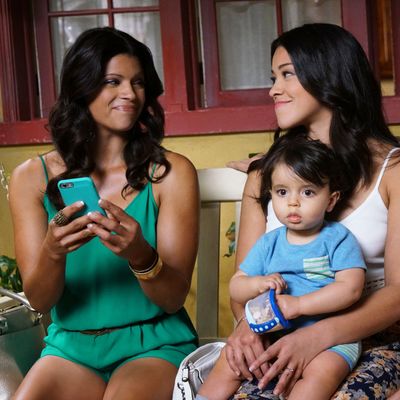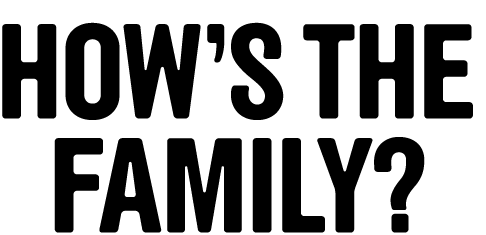
As long as there’s been TV, the family has been one of its favorite go-tos. All week long, Vulture is exploring how it’s been represented on our screens.
The competition is fierce. The Fosters is a vital, sincere, and gutsy TV vision of what families look like. The Middle’s Heck family is amazing, and I love Black-ish’s Johnsons fiercely and with abandon. One Day at a Time has some of the loveliest, most grounded, most absolutely endearing family dynamics on TV right now. Transparent’s Pfeffermans are strong candidates, and in its best moments, The Americans is a show about how to balance competing loyalties and how to choose to be a family.
But there is no better family on TV right now than Jane the Virgin’s Villanuevas. Do not be put off by the fact that they’re occasionally thrown down stairs, caught up in international drug rings, being kidnapped, or are pushed into other hypermelodramatic circumstances. Do not be put off by the show’s name, which I suspect is still telegraphing a sillier, more frivolous, less intelligently sincere show than it really is. Jane the Virgin’s Villanueva family is not just a great vision of what a TV family can look like (nonnuclear, nonwhite, matriarchal, malleable). They’re also the best illustration of how to tell stories about being a family who actually know one another.
The easiest way to start with the Villanueavas is who they are: a trio of women who mirror the Gilmore Girls if they were Venezuelan-American barely middle-class Miamians rather than Connecticut WASPs from ancient family wealth. Alba is a first-generation immigrant and spends much of the series as an undocumented worker, in fear for her precarious status. Her daughter, Xiomara, who had a baby as a teenager, is now a dance instructor and occasional lounge singer. Jane, Xiomara’s daughter, tries desperately to raise her son Mateo with a consciousness of his heritage and his comparative privilege. Throughout much of the series, Jane, Xo, and Alba live together in a small house. They ride the bus. They work in service jobs. They love grilled-cheese sandwiches and telenovelas and one another.
The plain facts of their identities and the nonnuclear shape of their family structure are important, but much less than you might think. TV families have been banking on the “what if a regular American family, but they’re different!” formula forever (cf. The Brady Bunch, The Addams Family, Grace Under Fire, Mr. Belvedere, Murphy Brown, Family Matters, One Day at a Time, Punky Brewster, I could go on for a very, very long time). What’s more interesting is the way Jane the Virgin uses its typically atypical family, and how they interact with one another. In any episode there may be five or six distinct stories happening, and the matriarchal Villanuevas are how Jane the Virgin keeps its many plates spinning over the long term.
So much of the show is defined by Jane’s love life — her push-me-pull-you relationship with Rafael, the marriage to Michael and the grief after it ends, the rebounds, the idea of true love and fate and romance. That kind of pointed “who will she end up with” storytelling is a powerful engine to drive a romance story, right up until the moment it doesn’t work anymore. At some point, love triangles collapse, and then a romance show has to figure out what else to be, scrambling for new sources of drama and tension. The Villanuevas are an insurance against that storytelling cliff. The three women’s romantic relationships come and go, but the show can always come back to the three of them and recenter itself in their relationships with one another. While off in the background the big bad Sin Rostro is swapping faces, Jane and her mother and grandmother are sitting on the swing in front of their home, talking quietly about their concerns and their hopes. These scenes are never particularly long, but they’re a steady, regular thrum at the center of Jane’s otherwise frantic rhythm.
This also feels like standard TV-family fare — of course they regularly have heartwarming moments with one another. They hug, and sometimes there are some tears, and everyone comes away feeling better. When you come down to it, what’s the difference between that and the end of a Full House episode? But Jane is also relentless in demanding that love be honest. The Villanuevas see each other. They criticize one another, as generously and compassionately as possible. Often they disagree, and sometimes those disagreements are enormous, worldview-sized gulfs: the founding tension of the show is that Jane’s grandmother believes in abstinence outside of marriage, and Jane continues to wrestle with the guilt and weight of that, years into the show’s run. Jane is perpetually frustrated with her mother, who often embarrasses her and tends to be less practical. These things come up in their conversations, again and again. They call one another out. They ask for advice, and raise their eyebrows at each other behind their backs when that advice goes unheeded. They have serious fights, and the resolutions are usually satisfying but never easy, because there are always tough conversations first. They see each other.
It’s astonishing how few TV families are built on something so radical and so simple as truly knowing one another. Most episodes of a show like Modern Family tend to operate on the reverse assumption, in fact – Gloria’s perpetually trying to do something that Claire finds utterly baffling; Manny looks at his cousins with total confusion; the married couples each seem to operate on completely different planes. Once you start looking for them, those tropes of mild, perplexed familial estrangement are everywhere, in the well-worn “what’s with the kids these days” crutch and the “my spouse doesn’t get me” story. The Americans is a show about whether any of them actually know one another; Transparent is a show about how they definitely do not know one another, although they certainly think they do. Most TV families have at least one kid who everyone looks at and just shrugs. Even a show like Black-ish, with a family as close-knit and transparent as the Johnsons, sometimes leans on the “wait, who the hell am I married to/living with?!” concept. And that’s probably as true to life as anything else about most fictional families. How many of us actually know our family members, really get them, in a deep, compassionate, clear-eyed way?
The Villanuevas are the best family on TV, not just because they’re real in the way of real families who watch TV together and live in a small house and don’t look like the family on Leave It to Beaver.
They’re real in a fantastically unreal way, too — they roll their eyes at one another and know enough to know that Xo says she wants the small wedding now, but she’ll change her mind soon, and they know ahead of time what Jane needs, and how to help her, and when to leave Alba alone. They’re a family who love each other in a way we all want to be loved, and see each other in a way we all want to be seen.



